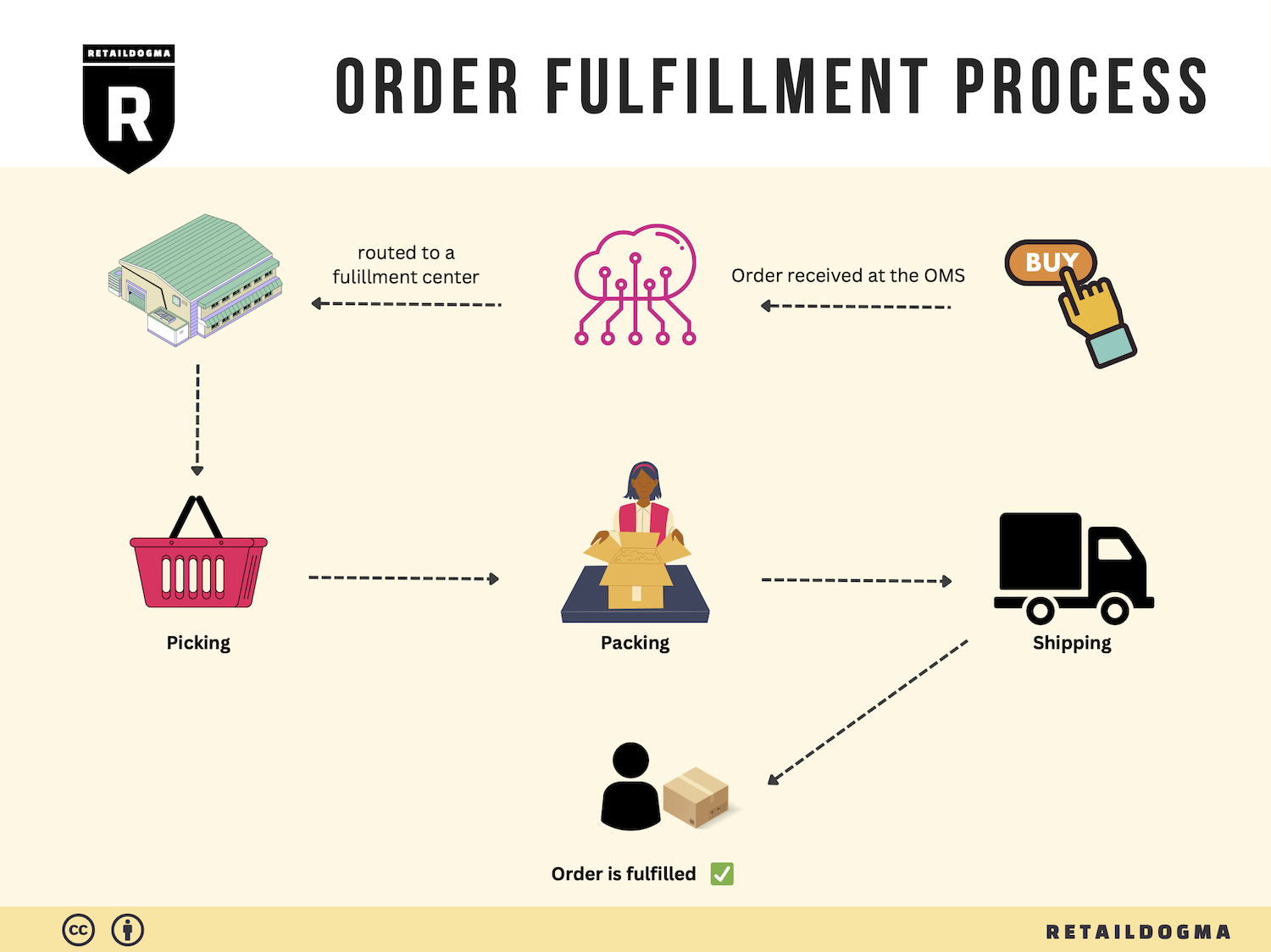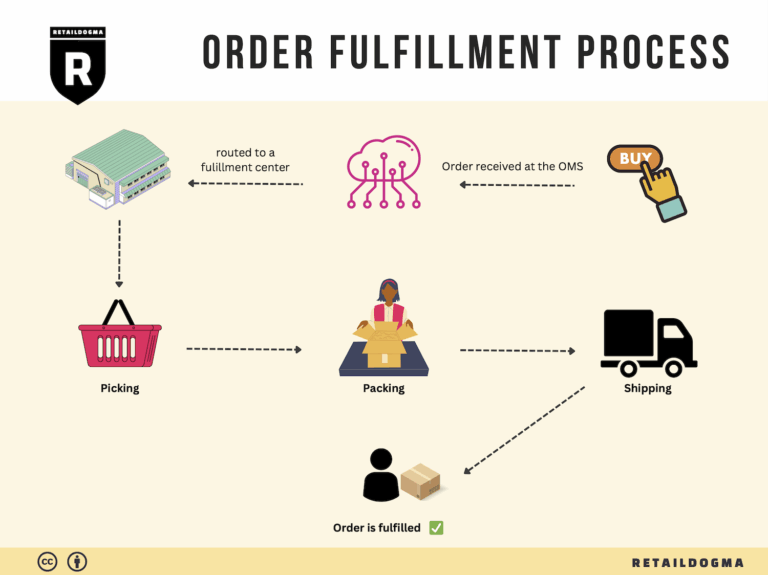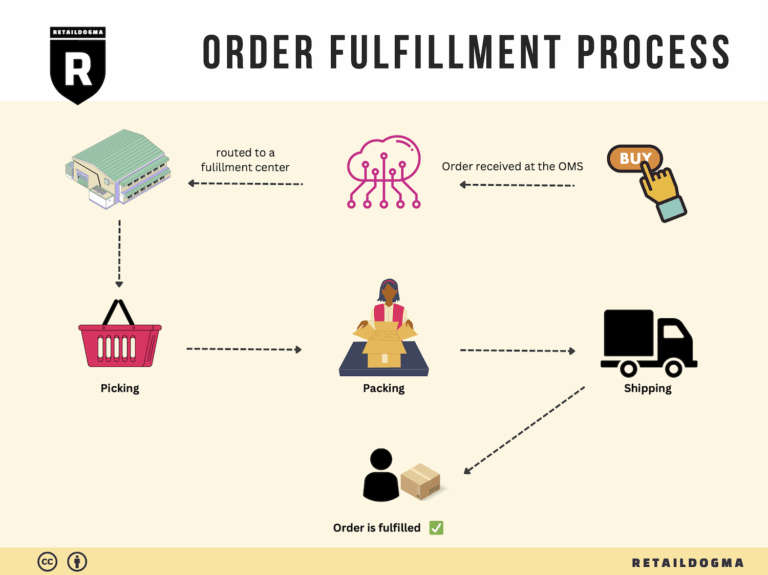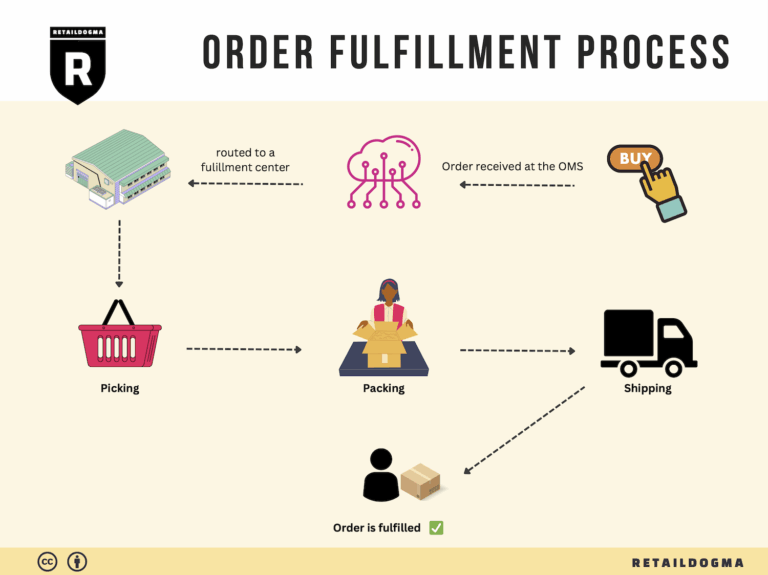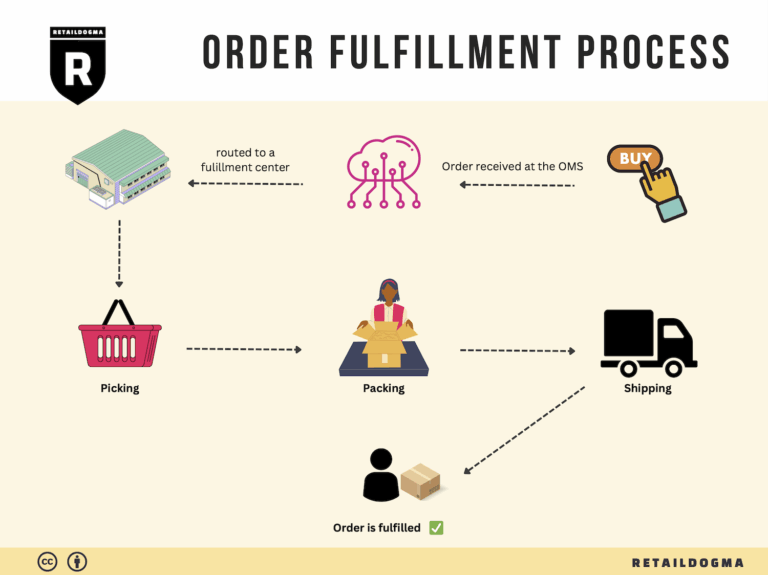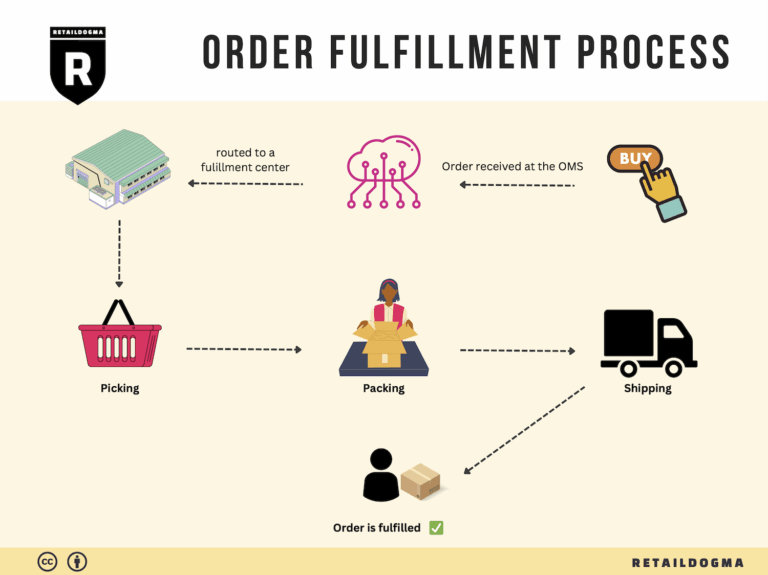How Order Fulfillment Works: A Step-by-Step Guide for Businesses
What is E-commerce Fulfillment? An Introduction for Growing Businesses
Understanding the Challenges of E-commerce Fulfillment
As an e-commerce business owner, you’re likely familiar with the exhilarating highs of growing sales, but you may also feel the pressure mounting as order volumes increase. One common pain point is the overwhelming task of packing and shipping orders—tasks that can quickly consume your time and resources. For many entrepreneurs, the joy of running an online store can be overshadowed by the logistical headaches of fulfillment.
Fulfillment is the critical process of getting a product from your warehouse to your customer’s doorstep. It encompasses everything from managing inventory and picking items to packing orders and shipping them out. As your business scales, so does the complexity of this process, making it essential to understand your options and streamline operations.
What This Guide Covers
In this comprehensive guide, we’ll explore various fulfillment models that can help you efficiently manage your logistics as you grow. We’ll dive into:
-
Fulfillment Models: Learn about different fulfillment options such as Third-Party Logistics (3PL) and Fulfillment by Amazon (FBA), and understand which model may suit your business needs.
-
Core Services: Discover the essential services offered by fulfillment partners, including inventory management, order processing, returns management, and more.

-
Choosing a Partner: We’ll provide practical tips on selecting the right fulfillment partner, ensuring they align with your brand’s values, operational needs, and growth ambitions.
-
Pricing Considerations: Gain insight into the cost structures of various fulfillment services, helping you budget and forecast expenses effectively.
Empowering Smart Decisions
The ultimate goal of this guide is to empower you—e-commerce business owners and operations managers—to make informed decisions about your logistics. With the right knowledge and resources, you can alleviate the burdens of fulfillment and focus on what truly matters: growing your business and delighting your customers.
By understanding the nuances of e-commerce fulfillment, you can navigate the complexities of logistics with confidence, ensuring that your operations are as scalable as your ambitions. Let’s embark on this journey together to optimize your fulfillment strategy and drive your business forward.
What You’ll Learn In This Guide
- What is E-commerce Fulfillment? An Introduction for Growing Businesses
- The Order Fulfillment Process: From ‘Buy’ Button to Customer’s Door
- Comparing Fulfillment Models: In-House vs. 3PL vs. Dropshipping
- A Deep Dive into Amazon FBA: Pros, Cons, and Who It’s For
- Core Services Offered by Fulfillment Centers
- How to Choose a Fulfillment Partner: A 6-Point Checklist
- Understanding Fulfillment Pricing: A Breakdown of Common Fees
- Frequently Asked Questions (FAQs) about Fulfillment
- Conclusion: Is Outsourcing Fulfillment the Right Move for Your Business?
- Important Disclaimer
The Order Fulfillment Process: From ‘Buy’ Button to Customer’s Door
1. Receiving Inventory
The first step in the order fulfillment process is receiving inventory. When products arrive at your fulfillment center, they must be checked for accuracy against the purchase orders and inspected for quality. This involves verifying the quantity and condition of each item, assigning a Stock Keeping Unit (SKU) for tracking, and entering the data into the inventory management system.
Importance: Accurate receiving is crucial because it lays the foundation for effective inventory management. Any discrepancies at this stage can lead to stockouts or overstock situations, which can harm customer satisfaction and your bottom line. A well-executed receiving process ensures that your inventory levels are accurate and up-to-date, helping you avoid costly mistakes.
Key Term: SKU (Stock Keeping Unit) – A unique identifier for each product that helps track inventory levels and sales.
2. Warehouse Storage
Once inventory is received and verified, the next step is warehouse storage. Products are organized and stored in designated locations within the warehouse, often categorized by size, weight, or type. This step involves utilizing warehouse management systems (WMS) to optimize the layout and ensure that items are easy to locate when orders come in.
Importance: Efficient warehouse storage is essential for maximizing space and improving order fulfillment speed. An organized storage system helps reduce the time spent searching for products, which in turn accelerates the picking process. Additionally, proper storage techniques can help prevent product damage and maintain quality.

Key Term: Warehouse Management System (WMS) – A software solution that helps manage inventory levels, track item locations, and optimize storage space.
3. Order Picking
Order picking is the process of selecting items from the warehouse to fulfill customer orders. When an order is placed, a pick list is generated, detailing the items and their locations within the warehouse. Warehouse staff then retrieve the specified products, often using technologies like barcode scanners or mobile devices to streamline the process.
Importance: The accuracy and efficiency of order picking directly impact customer satisfaction. Errors during this step can lead to incorrect shipments, resulting in returns and negative reviews. By employing effective picking strategies, such as batch picking or zone picking, businesses can enhance productivity and minimize mistakes.
Key Term: Pick List – A document or digital list that outlines the items to be picked for a specific customer order, including their locations in the warehouse.
4. Order Packing
After items are picked, they move to the packing stage. Here, the selected products are carefully packed into boxes or containers, ensuring that they are secure for shipment. This step may involve adding packing materials, labeling the packages, and generating shipping documents. Businesses often utilize packing stations equipped with tools and materials to streamline the process.
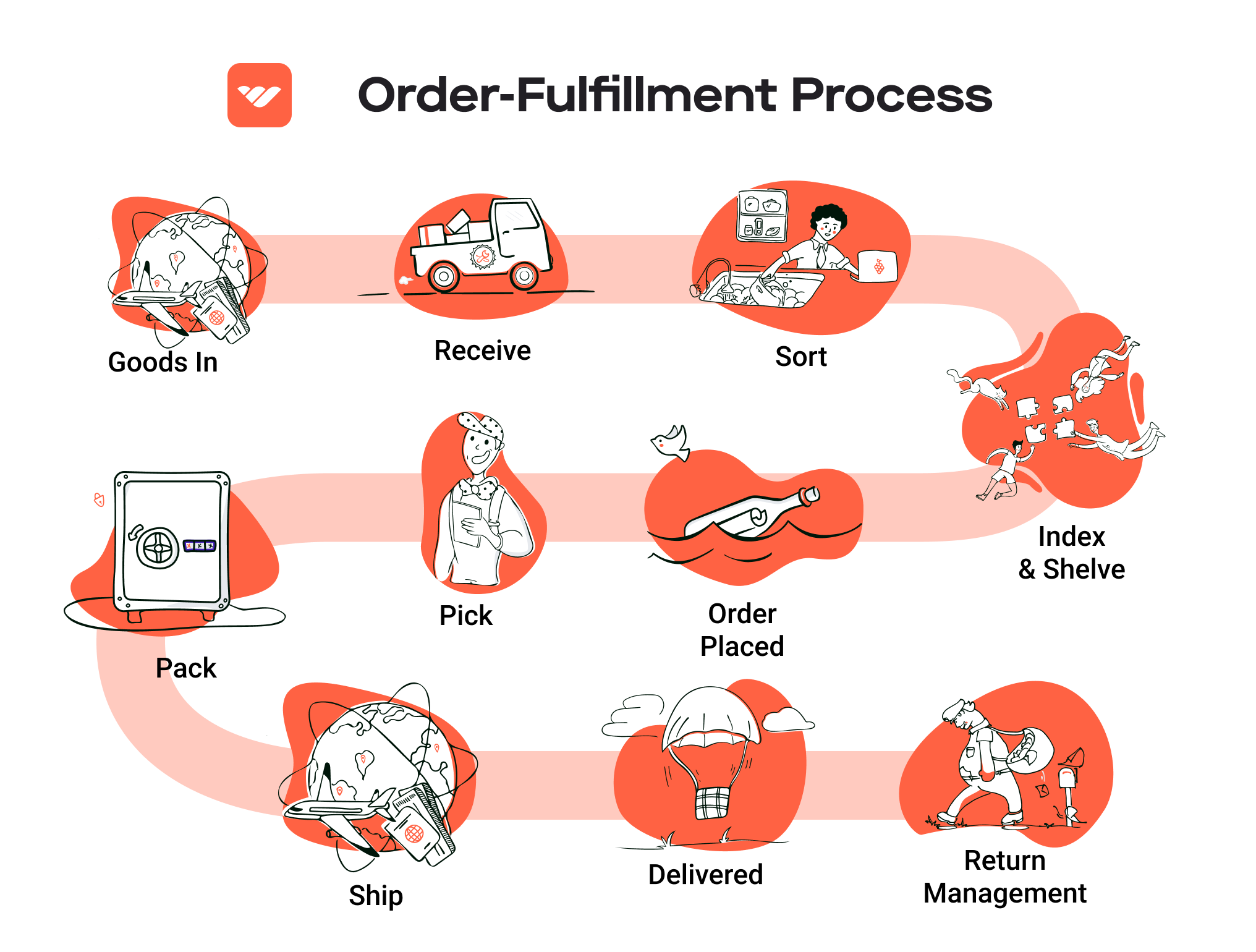
Importance: Proper packing is vital to prevent damage during transit and to create a positive unboxing experience for customers. Well-packed orders reduce the likelihood of returns due to damage, thereby enhancing customer satisfaction and retention. Additionally, efficient packing can help optimize shipping costs by minimizing package size and weight.
Key Term: Packing Station – A designated area within the warehouse where items are prepared for shipment, equipped with the necessary tools and materials for packing.
5. Shipping & Delivery
The final step in the order fulfillment process is shipping and delivery. Once orders are packed, they are handed over to shipping carriers for delivery to customers. This stage includes selecting the appropriate shipping method based on cost, speed, and customer preferences. Tracking information is often provided to customers to keep them informed about their order status.
Importance: Timely and accurate shipping is critical for customer satisfaction. Fast delivery times can significantly enhance the customer experience, while delays can lead to frustration and potential loss of future business. Establishing strong relationships with reliable shipping carriers and optimizing shipping routes can help ensure that orders arrive on time.
Key Term: Shipping Carrier – A company that transports packages from the fulfillment center to the customer, such as FedEx, UPS, or USPS.
By understanding and optimizing each of these steps, e-commerce businesses can significantly improve their order fulfillment processes, leading to higher customer satisfaction and increased operational efficiency.
Comparing Fulfillment Models: In-House vs. 3PL vs. Dropshipping
Fulfillment Model Comparison
| Model | Who Handles Inventory | Best For (Business Stage) | Key Advantage | Key Disadvantage |
|---|---|---|---|---|
| In-House Fulfillment | The business itself | Established businesses with stable sales | Full control over inventory and operations | High overhead costs and resource-intensive |
| Third-Party Logistics (3PL) | A third-party provider | Scaling businesses and startups | Reduced operational burden and expertise access | Potential loss of control over fulfillment |
| Dropshipping | Suppliers manage inventory | New businesses or low-risk models | Low upfront investment and minimal risk | Lower profit margins and less control over shipping |
In-House Fulfillment
In-house fulfillment refers to the process where a company manages its own inventory and shipping operations. This model is often adopted by established businesses that have a stable sales volume and enough resources to maintain their own warehouse and logistics team. The key advantage of in-house fulfillment is the complete control it provides over inventory management, order processing, and customer service. Businesses can implement customized processes that align with their brand values and customer expectations, ensuring that they can respond quickly to changes or issues. However, this model comes with significant disadvantages, including high overhead costs related to staffing, warehousing, and technology investments. Additionally, as order volume increases, the operational complexity can become burdensome, potentially leading to mistakes that can negatively impact customer satisfaction.
Third-Party Logistics (3PL)
Third-party logistics (3PL) involves outsourcing fulfillment operations to specialized logistics providers. This model is particularly advantageous for scaling businesses or startups that may not have the resources or infrastructure to manage fulfillment in-house. A major benefit of partnering with a 3PL is the reduction in operational burden; businesses can leverage the expertise and technology of the 3PL provider, allowing them to focus on core business functions such as marketing and product development. Additionally, 3PLs often have established networks that can provide faster shipping options and greater geographic reach. However, the trade-off is a potential loss of control over the fulfillment process. Companies must trust their 3PL partner to maintain quality standards, inventory accuracy, and timely shipping, which can be challenging if the 3PL does not meet the expected service levels.
Dropshipping
Dropshipping is a fulfillment model where retailers do not hold inventory but instead transfer customer orders and shipment details directly to a wholesaler or manufacturer. This model is particularly appealing to new businesses or entrepreneurs looking to enter the market with minimal financial risk. The key advantage of dropshipping is the low upfront investment required, as businesses do not need to purchase inventory upfront or manage warehousing. This model allows for a broad product range without the burden of unsold stock. However, dropshipping typically comes with lower profit margins due to reliance on suppliers, and retailers often have limited control over shipping times and product quality. This lack of control can lead to customer dissatisfaction if suppliers do not meet expectations, making it crucial for dropshippers to carefully vet their partners.
Conclusion
Choosing the right fulfillment model is a critical decision that can significantly impact your e-commerce business’s scalability, efficiency, and customer satisfaction. Each model has distinct advantages and challenges, and the best choice will depend on your business stage, product type, and operational capacity. As you consider your options, think about your long-term goals, the level of control you wish to maintain, and the resources you have available to invest in fulfillment. By aligning your fulfillment strategy with your overall business objectives, you can create a seamless experience for your customers and set the stage for sustainable growth.
A Deep Dive into Amazon FBA: Pros, Cons, and Who It’s For
Understanding Fulfillment by Amazon (FBA)
Fulfillment by Amazon (FBA) is a service that allows e-commerce sellers to store their products in Amazon’s fulfillment centers. Amazon then takes care of storage, packaging, shipping, and customer service on behalf of the sellers. This model leverages Amazon’s extensive logistics network, allowing sellers to reach millions of customers while focusing on other business operations.
How FBA Works
-
Setup: Sellers create an Amazon seller account and enroll in FBA. They list their products on Amazon, selecting FBA as the fulfillment method.
-
Inventory Shipment: Sellers prepare and ship their products to Amazon’s fulfillment centers. Amazon provides guidance on how to package and label items.
-
Storage and Order Management: Once the products are received, they are stored in Amazon’s warehouses. Amazon manages inventory levels, ensuring that products are available for purchase.
-
Order Fulfillment: When a customer places an order, Amazon picks, packs, and ships the product directly to the customer. They also handle returns and customer service inquiries.
-
Payment and Fees: After the sale, Amazon deducts FBA fees from the seller’s account, which includes storage fees and fulfillment fees based on product size and weight.
Pros of Using FBA
Prime Eligibility
One of the most significant advantages of FBA is that it grants products Prime eligibility. This means that products are eligible for Amazon Prime’s two-day shipping, which can significantly increase visibility and sales. Prime members are more likely to purchase products that qualify for their membership benefits, enhancing the seller’s market reach.
Customer Trust
Amazon is synonymous with trust and reliability. By using FBA, sellers can leverage Amazon’s brand reputation, which can lead to increased customer confidence in purchasing their products. The association with Amazon can help new sellers establish credibility in a competitive marketplace.
Multi-Channel Fulfillment
FBA is not limited to Amazon’s marketplace. Sellers can utilize FBA to fulfill orders from other sales channels, including their own websites or other e-commerce platforms. This flexibility allows businesses to streamline their logistics operations while benefiting from Amazon’s infrastructure.
Comprehensive Customer Support
With FBA, Amazon handles all customer service inquiries related to fulfillment. This includes managing returns and refunds, which can save sellers significant time and effort. For many sellers, this means they can focus more on product development and marketing rather than customer service logistics.
Cons of Using FBA
High Fees
One of the most significant downsides to FBA is the cost associated with the service. Amazon charges various fees, including fulfillment fees based on the size and weight of the products, as well as monthly storage fees for inventory stored in their warehouses. For some sellers, especially those with low margins, these fees can eat into profits significantly.
Strict Inventory Rules
Amazon enforces strict inventory management rules that sellers must follow. This includes maintaining accurate inventory levels and adhering to specific packaging and labeling requirements. Failure to comply can result in additional fees or even suspension of selling privileges.
Commingling Risks
FBA employs a commingled inventory model, where products from different sellers are stored together. This means that when a seller’s product is shipped, it may not always come from their specific stock. While this can streamline operations, it also poses risks, such as potential mislabeling or quality control issues, which can damage a seller’s reputation.
Limited Control Over Branding
When using FBA, sellers have limited control over the packaging and branding of their products. Amazon handles the fulfillment process, which means that products are often shipped in unbranded packaging. This can dilute a seller’s brand identity and may not provide the personalized experience that some businesses strive for.
Who is FBA Best For?
Fulfillment by Amazon is particularly advantageous for sellers who:
-
Have High Sales Volumes: Sellers who can leverage Amazon’s vast customer base and who anticipate a high volume of sales can benefit from the economies of scale that FBA offers.
-
Sell Fast-Moving Consumer Goods: Products with high turnover rates can offset the costs of FBA, making it a viable option for e-commerce businesses that deal with fast-moving inventory.
-
Prioritize Customer Experience: Sellers who value customer trust and want to provide a reliable shipping experience without managing logistics themselves will find FBA appealing.
-
Are New to E-Commerce: New entrepreneurs looking to enter the e-commerce space can benefit from the credibility and logistical support that FBA provides, allowing them to focus on growing their business without the complexities of fulfillment.
In summary, while Fulfillment by Amazon presents an attractive opportunity for many e-commerce businesses, it’s essential to weigh the pros and cons carefully. Understanding how FBA fits into your overall business strategy will help you make an informed decision on whether to utilize this service.
Core Services Offered by Fulfillment Centers
Inventory Management & Warehousing
Effective inventory management is the backbone of any successful e-commerce operation. Fulfillment centers provide specialized warehousing solutions that ensure your products are stored in an organized and efficient manner. This service involves tracking inventory levels, managing stock replenishment, and ensuring that products are readily available for shipment.
The benefits of robust inventory management are multifaceted. First, it minimizes the risk of stockouts or overstock situations, which can significantly impact customer satisfaction and cash flow. With accurate inventory tracking, businesses can make informed decisions about purchasing and sales strategies, ultimately enhancing profitability. Additionally, fulfillment centers often use advanced software systems that provide real-time visibility into inventory levels, allowing e-commerce businesses to maintain control over their stock from anywhere.
Pick and Pack Services
Once an order is placed, the next step is to pick and pack the items for shipment. Fulfillment centers excel in this area, employing streamlined processes to ensure that orders are filled quickly and accurately. The pick and pack service involves selecting the correct items from the warehouse, packing them securely, and preparing them for shipment.
The primary advantage of utilizing pick and pack services is the efficiency and accuracy it brings to order fulfillment. Fulfillment centers often operate with sophisticated inventory management systems that reduce the likelihood of errors, ensuring that customers receive exactly what they ordered. Furthermore, quick turnaround times in processing orders can significantly enhance customer satisfaction and loyalty. This service also allows e-commerce businesses to scale operations without the burden of managing the logistics of order fulfillment in-house.
Kitting and Assembly
Kitting and assembly is a value-added service that allows e-commerce businesses to bundle multiple products together into a single package or prepare products for sale in a ready-to-sell format. This could involve assembling components into a final product or simply grouping related items together, such as a gift set or promotional package.
The benefit of kitting and assembly lies in the enhanced customer experience and operational efficiency it provides. By offering bundled products, businesses can create unique offerings that attract customers and differentiate their brand in a competitive market. Additionally, this service can streamline the shipping process, as bundled items can be shipped as a single package, reducing shipping costs and time. For businesses looking to optimize their inventory management and product offerings, kitting and assembly can be a game-changer.
Returns Management (Reverse Logistics)
Returns management, often referred to as reverse logistics, is a critical service offered by fulfillment centers. This process involves handling returned products efficiently and effectively, ensuring that returns are processed quickly and accurately. Fulfillment centers provide the infrastructure needed to manage returns, including inspection, restocking, and processing refunds or exchanges.
The importance of effective returns management cannot be overstated, as it directly impacts customer satisfaction and retention. A seamless returns process can enhance customer trust and loyalty, encouraging repeat purchases. Furthermore, fulfillment centers can analyze return data to identify trends and issues, enabling businesses to address product quality concerns or adjust their offerings accordingly. By outsourcing returns management, e-commerce businesses can focus on growth and customer engagement while ensuring that their returns are handled with care and efficiency.
In conclusion, partnering with a fulfillment center can significantly enhance the operational capabilities of an e-commerce business. Services like inventory management, pick and pack, kitting and assembly, and returns management not only streamline logistics but also contribute to a superior customer experience. As businesses scale, leveraging these core services becomes essential for maintaining efficiency and meeting customer expectations in a competitive marketplace.
How to Choose a Fulfillment Partner: A 6-Point Checklist
Location & Warehouse Network
Why It’s Important
The location of your fulfillment partner’s warehouses significantly impacts shipping times and costs. A strategically placed warehouse can reduce transit times, enhance customer satisfaction, and lower shipping expenses. For e-commerce businesses aiming to reach a broad customer base quickly, this is a crucial factor.
Questions to Ask
– Where are your warehouses located, and how does that affect shipping times to my target markets?
– Can you provide a map of your shipping zones and the average delivery times for each zone?
– How do you handle international shipping, and what are the associated costs?
Technology & Integrations
Why It’s Important
In today’s digital age, seamless technology integration is essential for efficient operations. A good fulfillment partner should be able to integrate with your e-commerce platform and provide real-time data on inventory levels, order status, and shipping tracking. This capability allows you to streamline operations and improve customer experience.
Questions to Ask
– What e-commerce platforms do you integrate with, and how is this integration managed?
– Can you provide real-time inventory and order tracking capabilities?
– Do you offer custom API solutions if I require specialized integrations?
Specializations (e.g., Cold Storage, Oversized Items)
Why It’s Important
Different businesses have unique needs depending on the nature of their products. If you deal with perishable goods, oversized items, or specialized products, you need a fulfillment partner with the right expertise and facilities to handle these items properly. This ensures compliance with safety regulations and minimizes damage during storage and shipping.
Questions to Ask
– What specializations do you have that align with my product offerings?
– Do you have facilities for cold storage or handling oversized items?
– Can you provide case studies or references for businesses with similar needs?
Scalability & Capacity
Why It’s Important
As your business grows, your fulfillment needs will evolve. Choosing a partner with scalable solutions ensures that you can handle fluctuations in order volume without compromising service quality. A partner with adequate capacity can accommodate seasonal spikes in demand, which is vital for maintaining customer satisfaction during peak periods.
Questions to Ask
– What is your maximum capacity for handling orders, and how quickly can you scale up operations?
– How do you manage peak seasons or unexpected spikes in order volume?
– Can you provide examples of how you’ve supported clients through growth phases?
Pricing and Contracts
Why It’s Important
Understanding the pricing structure and contractual obligations is critical to ensuring that you can manage your budget effectively. Hidden fees can significantly affect your bottom line, so clarity in pricing is essential. Additionally, the terms of the contract should allow for flexibility as your needs change.
Questions to Ask
– What is your pricing model, and what factors influence the costs?
– Are there any hidden fees for services like storage, packing, or shipping?
– What are the terms of the contract, and is there flexibility for renegotiation if my business scales?
Customer Support & Reviews
Why It’s Important
Reliable customer support is essential for resolving issues quickly and maintaining smooth operations. Additionally, reviews and testimonials from other clients can provide insight into the partner’s reliability and service quality. A partner with strong customer support can be a vital ally in your business’s success.
Questions to Ask
– What kind of customer support do you offer (e.g., 24/7 availability, dedicated account managers)?
– Can you provide references from current or past clients, particularly those in my industry?
– How do you handle errors or disputes regarding order fulfillment?
Conclusion
Choosing the right fulfillment partner is a crucial decision that can significantly impact your e-commerce business. By carefully considering factors such as location, technology, specialization, scalability, pricing, and customer support, you can make an informed choice that aligns with your business goals. Use this checklist as a guide to ensure that you partner with a fulfillment provider that will support your growth and enhance your customer experience.
Understanding Fulfillment Pricing: A Breakdown of Common Fees
Initial Setup Fees
Initial setup fees are often the first costs incurred when partnering with a fulfillment provider. These fees cover the onboarding process and can include various components such as account setup, system integration, and training. Depending on the complexity of your operations, these fees can vary significantly. For example, if your business requires a custom API integration with your e-commerce platform, the setup fee may be higher due to additional technical work.
To calculate initial setup fees, fulfillment centers typically consider the time and resources needed to integrate your systems with theirs, as well as any unique requirements your business may have. Be prepared to discuss your specific needs to get a more accurate estimate.
Receiving Fees
Receiving fees are charged when your inventory arrives at the fulfillment center. This fee accounts for the labor and resources used to unload, inspect, and store your products. These fees can vary based on the type of products you are sending. For example, bulky or heavy items may incur higher receiving fees due to the additional handling required.
Typically, receiving fees are calculated per pallet or per item received. Some fulfillment centers may also charge for extra services like quality checks or repackaging, which can further influence the overall cost. To minimize receiving fees, ensure that your shipments are well-organized and properly labeled.
Storage Fees (per pallet/bin)
Storage fees are recurring charges that cover the cost of keeping your inventory in the fulfillment center. These fees are usually calculated on a per-pallet or per-bin basis, depending on the layout and storage system of the warehouse. The amount you pay can vary based on the size and weight of your products, as larger or heavier items may require more space or specialized storage.
To get a clearer picture of storage costs, consider the following factors:
– Duration: Most fulfillment centers charge monthly, so consider how long your products are likely to stay in storage.
– Volume: Higher volumes may qualify for discounted rates, so it’s beneficial to discuss your expected inventory levels with your fulfillment provider.
Pick & Pack Fees (per item/order)
Pick and pack fees are charged for the labor involved in retrieving items from storage and preparing them for shipment. This fee is typically calculated per item or per order, meaning the more items you have in an order, the higher your pick and pack costs will be.
Some fulfillment centers offer tiered pricing based on order volume, which can help you save costs as your business scales. For example, if you ship a high volume of orders each month, you may qualify for lower pick and pack rates.
To optimize these fees, consider streamlining your product offerings or bundling items together to reduce the number of picks per order. Additionally, ensure your inventory is well-organized within the warehouse to facilitate quicker picking.
Shipping Fees
Shipping fees are the costs associated with transporting your orders to customers. These can vary widely based on several factors, including:
– Shipping Method: Ground, expedited, or international shipping will all have different costs.
– Destination: Shipping to different zones or regions can affect pricing.
– Package Size and Weight: Heavier and larger packages typically incur higher shipping costs.
Fulfillment providers may offer discounted shipping rates through their partnerships with carriers, which can be a significant advantage for e-commerce businesses. When calculating shipping fees, consider negotiating rates based on your expected shipping volume to lower costs further.
Tips for Getting an Accurate Quote
-
Be Transparent: Provide your fulfillment partner with clear and comprehensive details about your products, order volumes, and specific needs. The more information you provide, the more accurate your quote will be.
-
Ask About Additional Fees: Inquire about any potential hidden fees, such as those for returns, special handling, or inventory audits.
-
Consider Future Growth: When discussing pricing, consider your business’s growth trajectory. Ask about how fees may change as your order volumes increase.
-
Request a Detailed Breakdown: Ensure the quote includes a detailed breakdown of all charges, so you can understand where your costs are coming from and identify areas where you may save.
-
Compare Multiple Providers: Don’t settle for the first quote you receive. Compare offerings from different fulfillment centers to ensure you are getting the best value for your specific needs.
By understanding these common fulfillment pricing models and following these tips, you can make more informed decisions that align with your business’s growth and operational goals.
Frequently Asked Questions (FAQs) about Fulfillment
1. What is Red Stag Fulfillment?
Red Stag Fulfillment is a third-party logistics (3PL) provider specializing in e-commerce fulfillment services. With a focus on enterprise and fast-growing brands, Red Stag offers efficient order processing, inventory management, and shipping solutions tailored to meet the needs of businesses selling direct-to-consumer (DTC) and through various retail channels.
2. What is a 3PL?
A 3PL, or third-party logistics provider, is a company that manages logistics and fulfillment operations on behalf of another business. This includes warehousing, inventory management, order fulfillment, shipping, and returns management. By outsourcing these functions to a 3PL, businesses can focus on core activities such as marketing and sales while leveraging the expertise and infrastructure of the logistics provider.
3. How does Red Stag ensure accuracy in order fulfillment?
Red Stag Fulfillment prides itself on its accuracy guarantees, with a reported fulfillment accuracy rate of 99.99%. This is achieved through rigorous processes, advanced technology, and a dedicated team that closely monitors operations. Their performance metrics show that they maintain a low rate of mispicks and shipping delays, ensuring that customers receive the correct items on time.
4. What is the difference between a warehouse and a fulfillment center?
A warehouse is primarily a storage facility for goods, whereas a fulfillment center is a specialized warehouse designed for order fulfillment. Fulfillment centers not only store products but also pick, pack, and ship orders directly to customers. They typically have advanced technology and processes in place to manage inventory and process orders efficiently, which is essential for e-commerce operations.
5. How much do fulfillment services cost?
The cost of fulfillment services can vary significantly based on several factors, including the size and weight of the products, order volume, and specific services required (e.g., kitting, returns management). Red Stag Fulfillment offers custom quotes tailored to your business needs, allowing you to understand the costs associated with their services upfront. Generally, costs include storage fees, pick and pack fees, and shipping costs.
6. What types of products are suitable for Red Stag Fulfillment?
Red Stag Fulfillment specializes in handling big, heavy, and bulky items, as well as high-volume fulfillment for various product categories. They accommodate a wide range of products, including but not limited to electronics, home goods, sporting equipment, and apparel. Their facilities and processes are designed to efficiently manage diverse inventory types.
7. How quickly can Red Stag fulfill orders?
Red Stag Fulfillment offers same-day shipping for orders received before the cutoff time. Their strategically located warehouses in Sweetwater, TN, and Salt Lake City, UT, allow them to reach 96% of the U.S. population within two days using ground shipping. This rapid fulfillment capability is essential for businesses looking to meet customer expectations for fast delivery.
8. What kind of support does Red Stag provide during peak seasons?
Red Stag Fulfillment has a proven track record of maintaining high performance during peak seasons, such as holidays and promotional events. Their operational metrics during these times show consistent accuracy rates in inventory and fulfillment, ensuring that businesses can scale efficiently without compromising service quality.
9. Can Red Stag integrate with my existing e-commerce platform?
Yes, Red Stag Fulfillment seamlessly integrates with all major e-commerce platforms, including Shopify, Amazon, and Walmart. They also offer custom API integrations for businesses with unique requirements, ensuring that inventory and order management processes remain synchronized across all sales channels.
10. What guarantees does Red Stag Fulfillment offer?
Red Stag Fulfillment provides several industry-leading guarantees to ensure peace of mind for their clients. These include a no shrinkage guarantee (ensuring no lost or damaged inventory), a fulfillment accuracy guarantee, a shipping guarantee for on-time deliveries, and a receiving guarantee for quick inventory processing. These commitments reflect their dedication to reliability and customer satisfaction.
Conclusion: Is Outsourcing Fulfillment the Right Move for Your Business?
Evaluating the Benefits of Outsourcing Fulfillment
Outsourcing your fulfillment operations can be a transformative decision for your e-commerce business. By leveraging a third-party logistics (3PL) provider, you can save valuable time that can be redirected towards strategic initiatives like marketing and product development. As many business owners have discovered, the burden of managing logistics can be overwhelming; outsourcing allows you to focus on what you do best—growing your brand.
Scalability is another critical advantage of partnering with a fulfillment service. As your business experiences fluctuations in order volume, whether during peak seasons or unexpected surges, a reliable 3PL can accommodate your needs without the complexities of scaling your own operations. This flexibility ensures that you can meet customer demands efficiently, maintaining high levels of service and satisfaction.
Moreover, a specialized fulfillment partner brings expertise that can significantly enhance your operational efficiency. Providers like Red Stag Fulfillment not only offer advanced inventory management and shipping solutions but also have established relationships with carriers, ensuring competitive rates and reliable service. Their proven track record of accuracy and speed can be a game-changer for your logistics strategy.
However, it’s essential to choose the right fulfillment partner for your business. Consider factors such as their track record, capabilities, and how well they align with your specific needs. A poor choice can lead to operational headaches and customer dissatisfaction.
Take Action
To determine whether outsourcing fulfillment is the right move for you, conduct a thorough audit of your current shipping processes. Analyze your fulfillment costs, delivery times, and the resources you allocate to logistics. This assessment will provide clarity on whether a partnership with a 3PL could enhance your operational efficiency and support your growth ambitions. Start today by evaluating your logistics strategy—your future success may depend on it.
Important Disclaimer
⚠️ Important Disclaimer
The information in this guide is for educational purposes. Fulfillment services, pricing, and platform features change frequently. Always conduct your own due diligence and consult with providers directly before making business decisions.
